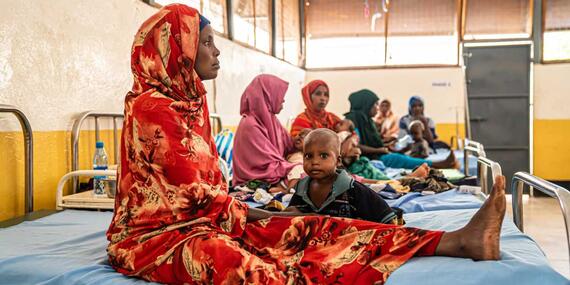Today's top news: Somalia, Syria, Türkiye, Ukraine

Somalia
Results from the latest multi-partner post-deyr Integrated Phase Classification (IPC) analysis show a slight improvement from previous projections, however an estimated 5 million people are experiencing crisis or worse outcomes between January and March. This includes 96,000 people facing catastrophic hunger.
It is estimated that approximately 1.8 million children will be acutely malnourished in 2023, including almost 478,000 children who are likely to be severely malnourished.
The analysis attributes the improvements from previous projections to large scale humanitarian assistance. The number of people reached with food assistance went from an average of 2 million people per month between January and March 2022 to an average of 5.4 million people per month between October and December 2022. It also attributes the improvement to better rains, albeit below average.
However, partners caution that the underlying crisis has not improved, and even more appalling outcomes have only temporarily been averted.
The IPC analysis indicates that rural agropastoral communities in Burhakaba District and displaced people in Baidoa and Mogadishu face the risk of famine between April to June 2023 if the 2023 Gu season rains fail and humanitarian assistance does not reach those most in need. Moreover 6.5 million people are expected to face crisis or worse food insecurity outcomes from April to June.
Based on current funding levels, humanitarian assistance is expected to reduce significantly between April and June 2023.
The Humanitarian Response Plan for Somalia seeks over US $2.6 billion to meet priority needs of 7.6 million vulnerable people. Additional funds are urgently required to sustain the response beyond March.
In addition to the immediate efforts to save lives, we call on donors, Member States, financial institutions, and the private sector to focus on long-term development and climate adaptation programmes to curb the causes of famine.
Syria, Türkiye
In Türkiye and Syria, many first responders were victims of the earthquake. As of 27 February, 88 humanitarian workers lost their lives due to the earthquakes: 18 of them in Türkiye and 70 in north-west Syria.
Today, 33 UN trucks from World Food Programme, International Organization for Migration, UN Children’s Fund (UNICEF) and the UN Refugee Agency (UNHCR), crossed into north-west Syria through the three crossings of Bab Al-Hawa (22 trucks), Bab Al-Salam (5) and Al-Ra’ee (6). This brings the total to 456 UN trucks that have crossed into north-west Syria since 9 February, through the three crossings of Bab Al-Hawa, Bab Al-Salam and Al-Ra’ee.
Scale-up of the shelter response, winterization, and multi-purpose cash support remain a priority. More funding is urgently needed to scale up the response:
- In Syria: $167.8 million reported against the Flash Appeal - 42.2 per cent.
- In Türkiye: $74.3 million reported against the Flash Appeal - 7.4 per cent.
Ukraine
Turning to Ukraine, our humanitarian colleagues tell us they are concerned about civilians who remain in Bakhmut city in the eastern Donetsk region. Although we cannot verify the figures due to limited access, partners have told us that some 4,000 civilians, compared with pre-war 73,000 residents, remain in the city, taking cover in basements and shelters.
With the tense security situation, very few humanitarian and volunteer organizations remain in the area, and most people in the city therefore rely mainly on the remaining humanitarian supplies from previous distributions. Centralized water, electricity and heating supplies in Bakhmut are reportedly interrupted due to the damage to the civilian infrastructure.
Civilians must be protected, including having the possibility to safely leave the area of hostilities in the direction of their choice.
Also on the Donetsk region, over the last several days, several civilians, including children, were killed or injured on both sides of the front line, according to the Ukrainian Government and the Russian-installed authorities.
Education and health facilities were also reportedly damaged on both sides of the front line.
This month, humanitarians sent six inter-agency convoys to the Donetsk region with food, water, winter and shelter materials to support some 77,000 people.
